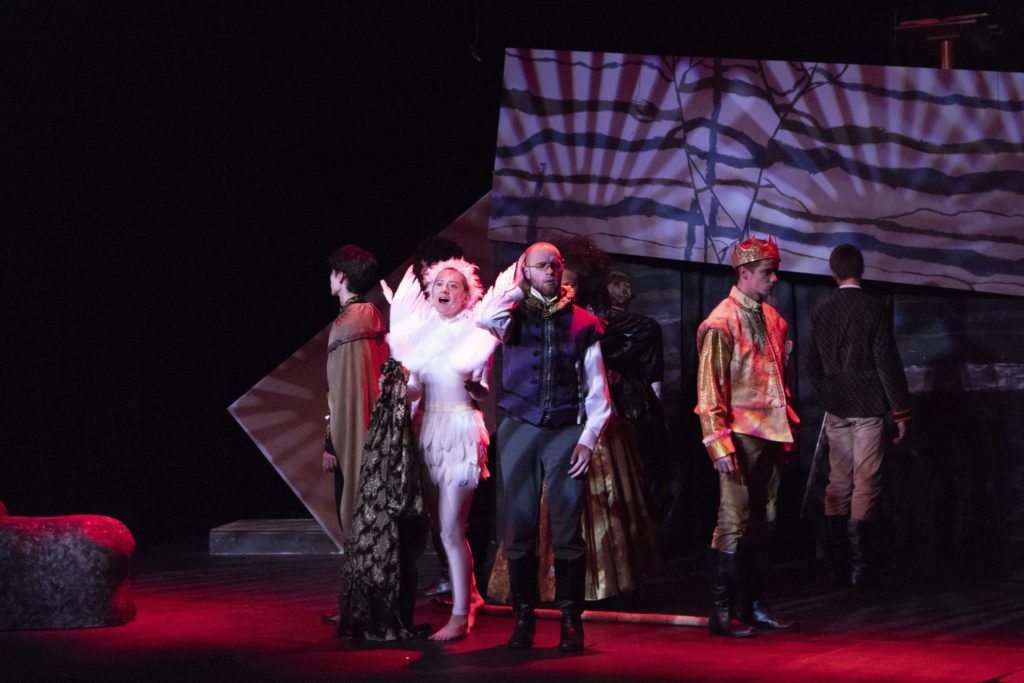
Under the tutelage of Hillsdale Academy Director of Dramatic Theater Kathryn Wales, students from the Hillsdale Academy performed a slightly modernized rendition of William Shakespeare’s “The Tempest” for their spring show on Friday April 12 and Saturday April 13.
In 2017, the Academy performed “Midsummer Night’s Dream,” which was the first time the school had performed a Shakespeare production in 27 years. This year, Wales believed that the seniors could perform a play that was a little more challenging.
“The senior students could manage the play because of their experience with poetry memorization and their appreciation for Shakespeare — because of their classical education,” Wales said. “I think they really pulled it off.”
The first act of the romantic comedy opens in the middle of a tempest, with the King of Naples ship desperate to stay afloat. The second scene takes place on the mainland, and the audience is introduced to the sorceress, Prospera, and her daughter Miranda, both of whom were mutinied on the island because Prospera’s brother Antonio betrayed her and stole her claim to be Duchess of Milan.
Throughout the play, Prospera enlists the help of a sprite named Ariel to perform magical feats to bring the King and his men –– Antonio included –– to her lair. One of her earliest feats was luring the King’s son Ferdinand to Prospera’s home. The sorceress coerced a ghastly slave creature named Caliban to make her island life easier. Her harsh treatment of both beings reflected her inner struggle to treat others with compassion, after being so wronged by her brother. The tension to treat others humanely was a theme that manifested itself throughout the play, and was resolved at its completion.
The only major change which the Academy made to the play was to make the originally male main character, Prospero, a female, Prospera.
In the original “Tempest,” the audience is told how Prospero is deeply steeped in the liberal arts tradition, and well read. To represent Prospera’s education, a copy of Boethius’ “Consolation of Philosophy” lays upon Prospera’s podium in her study overlooking the stage.
The book, which popularized the philosophical concept of an ever-moving “wheel of fortune,” with happiness and sorrow always temporary, pairs well with the various movements from “Carmina Burana,” the cantata that plays throughout the production, Wales explained. The cantata begins with the song “O Fortuna,” and has elements of the song in other songs. By linking these ideas, she said when Prospera is seduced by Fortuna, she is therefore trapped on the wheel of vice, which is demonstrated by her cruel treatment of other characters and her desire for vengeance against those who wronged her.
The music drastically influenced other characters besides Prospera. Nearly every movement from “Carmina Burana” was used, and according to Wales, this pairing has never been done before. Academy music teacher Ross Bonjernoor helped with the music for both Shakespeare productions.
“Mr. Bonjernoor borrowed the melody that underlies the lyrics of number three ‘Veris Leta Facies’ and fit it to the text of Ariel’s song,” Wales said. “It was perfect.”
Bonjernoor added to the depth of Ariel’s ethereal nature, simply by making her sing rather speak.
Immediately before Prospera’s epilogue, the penultimate song from “Carmina Burana,” “Ave Formosissima,” plays.
“Those who know the music expect a reprise of ‘O Fortuna’ which is a bleak, despairing resolution since it goes right back where it all started like any vicious cycle,” Wales said, “But instead, our Prospera hangs on the final note of ‘generosa’ and then launches into her epilogue.”
The nine months of preparation that went into the unabridged 2423-line production, really showed in the high school cast’s clear delivery and emotion.
In the final scene, Prospera makes amends with King Alonso by returning the prince. She forgives Antonio for his treachery, and has her title of Duchess restored. In the epilogue, she reveals that without the audience’s help, she cannot be permitted to leave the enchanted island.
“There she implores the audience to set her free: from the wheel, from the island, and from her sins. Our applause does so, not returning to ‘O Fortuna’ but instead embracing Philosophia and her fruits –– forgiveness, friendship, love,” she said.
Wales said she hopes student actors will remember the play’s lines in their bones, and fall back on its ideas when they experience tempests in their own life — especially when tempted to hold a grudge — to recall that the only remedy is forgiveness.

